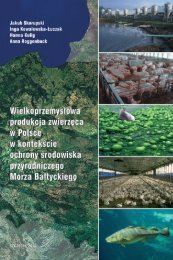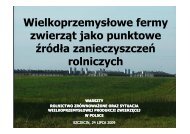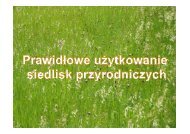best available technologies for manure treatment - Baltic Green Belt
best available technologies for manure treatment - Baltic Green Belt
best available technologies for manure treatment - Baltic Green Belt
Create successful ePaper yourself
Turn your PDF publications into a flip-book with our unique Google optimized e-Paper software.
Best Available Technologies <strong>for</strong> <strong>manure</strong> <strong>treatment</strong> baltic sea 2020<br />
ANNEX I: REPORT FROM ROUNDTABLE DISCUSSION<br />
higher field effect in digested slurry. A longer discussion<br />
happened about the field effect. It was finally<br />
concluded that the field effect is a useful indicator <strong>for</strong><br />
evaluation of some of the livestock <strong>manure</strong> <strong>treatment</strong><br />
<strong>technologies</strong>’ effect on leaching reduction.<br />
The matter about farmer cooperation was also<br />
subject <strong>for</strong> many comments. It was generally the opinion,<br />
that the project could promote larger livestock<br />
<strong>manure</strong> <strong>treatment</strong> plants <strong>for</strong> combined <strong>technologies</strong>,<br />
and that this even would take away the structural<br />
development pressure on the pig producers, which<br />
somehow would be a result in itself.<br />
Re. 8: Survey result<br />
The time was scarce, and Henning Foged said that<br />
although only 10 persons had completed the survey<br />
at that stage he saw some clear trend in the answers:<br />
• All respondents says there is a considerable leaching<br />
of N and P that ends in the marine environment<br />
(30% leaching of N and 21% leaching of P)<br />
• There is a clear expectation to an increase in the<br />
deployment of livestock <strong>manure</strong> <strong>treatment</strong><br />
<strong>technologies</strong> (from an estimate of 3% in 1990 to<br />
an expectation to 38% in 2020)<br />
• 7 out of 10 respondents see a link between leaching<br />
and livestock <strong>manure</strong> <strong>treatment</strong> <strong>technologies</strong><br />
• Respondents consider the implementation of the<br />
IPPC legislation to be rather effective, but also<br />
that it does probably not have the focus on leaching<br />
of N and P and how this could be reduced<br />
with livestock <strong>manure</strong> <strong>treatment</strong> <strong>technologies</strong><br />
Henning concluded that “As use of livestock <strong>manure</strong><br />
<strong>treatment</strong> <strong>technologies</strong> becomes more and more<br />
widespread, and as (some of them) have an effect<br />
on leaching of N and P (and sometimes also other<br />
environmental effects), there is a clear justification<br />
to increase the focus on livestock <strong>manure</strong> <strong>treatment</strong><br />
<strong>technologies</strong> in the BREF <strong>for</strong> installations <strong>for</strong> the<br />
intensive rearing of pigs”.<br />
Re. 9: Summarising and concluding<br />
Lotta Samuelson thanked <strong>for</strong> the participation and<br />
the good input into the discussions. <strong>Baltic</strong> Sea 2020<br />
will send conclusions from the meeting to participants,<br />
and will also consider sending out the project<br />
report <strong>for</strong> comments.<br />
93








